Problems of Substance Abuse and Alcohol Misuse
VerifiedAdded on 2023/01/19
|7
|1772
|84
AI Summary
This essay aims to carry out an assessment on health promotion to help Jayne who is a 22-year-old student at his final year of studies at University and has health problems associated with substance abuse. The essay will discuss the efficient assessment tool that can be effective in planning care for Jayne. Several tools can be used in planning for health promotion of a patient but depend on health issue affecting the client.
Contribute Materials
Your contribution can guide someone’s learning journey. Share your
documents today.
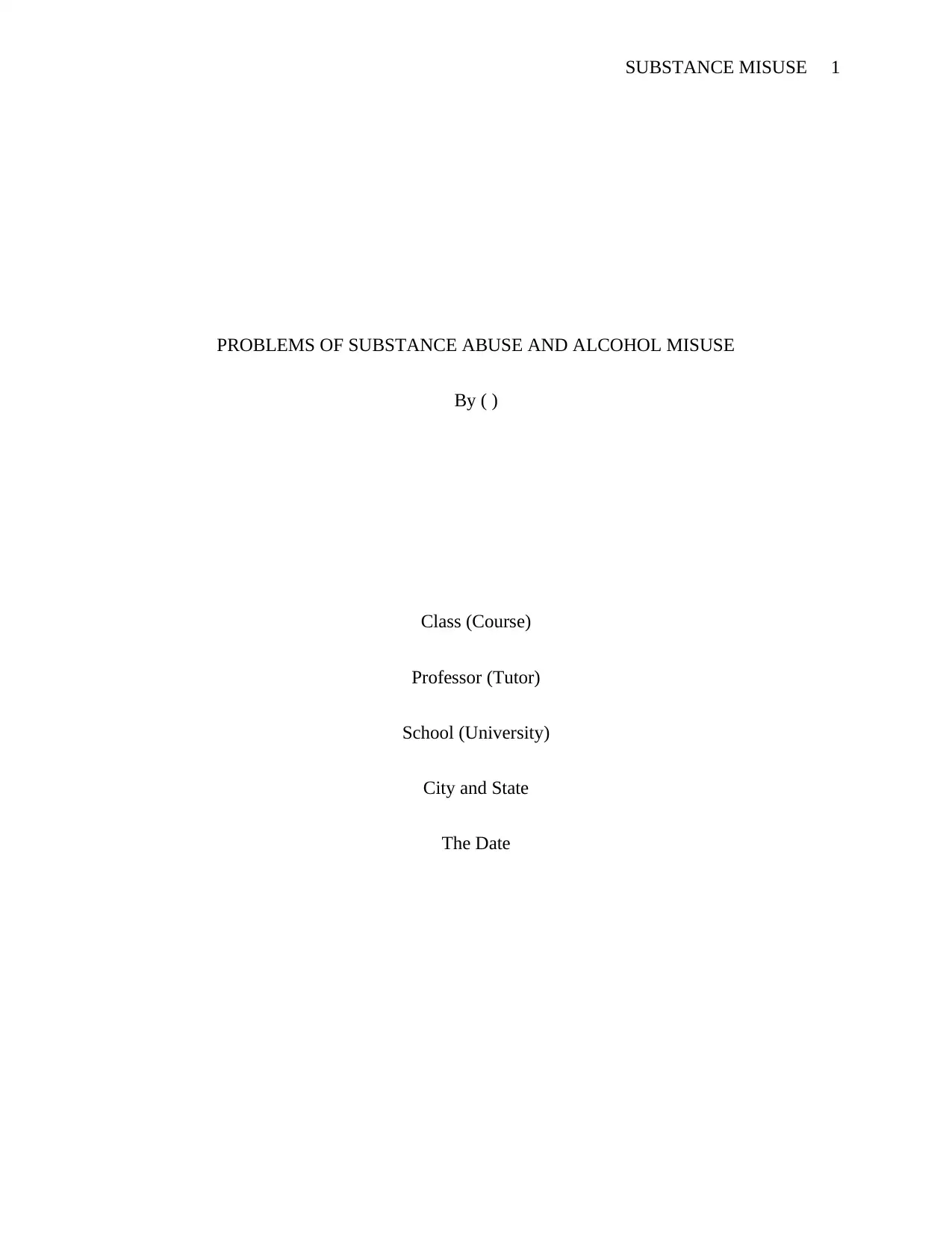
SUBSTANCE MISUSE 1
PROBLEMS OF SUBSTANCE ABUSE AND ALCOHOL MISUSE
By ( )
Class (Course)
Professor (Tutor)
School (University)
City and State
The Date
PROBLEMS OF SUBSTANCE ABUSE AND ALCOHOL MISUSE
By ( )
Class (Course)
Professor (Tutor)
School (University)
City and State
The Date
Secure Best Marks with AI Grader
Need help grading? Try our AI Grader for instant feedback on your assignments.
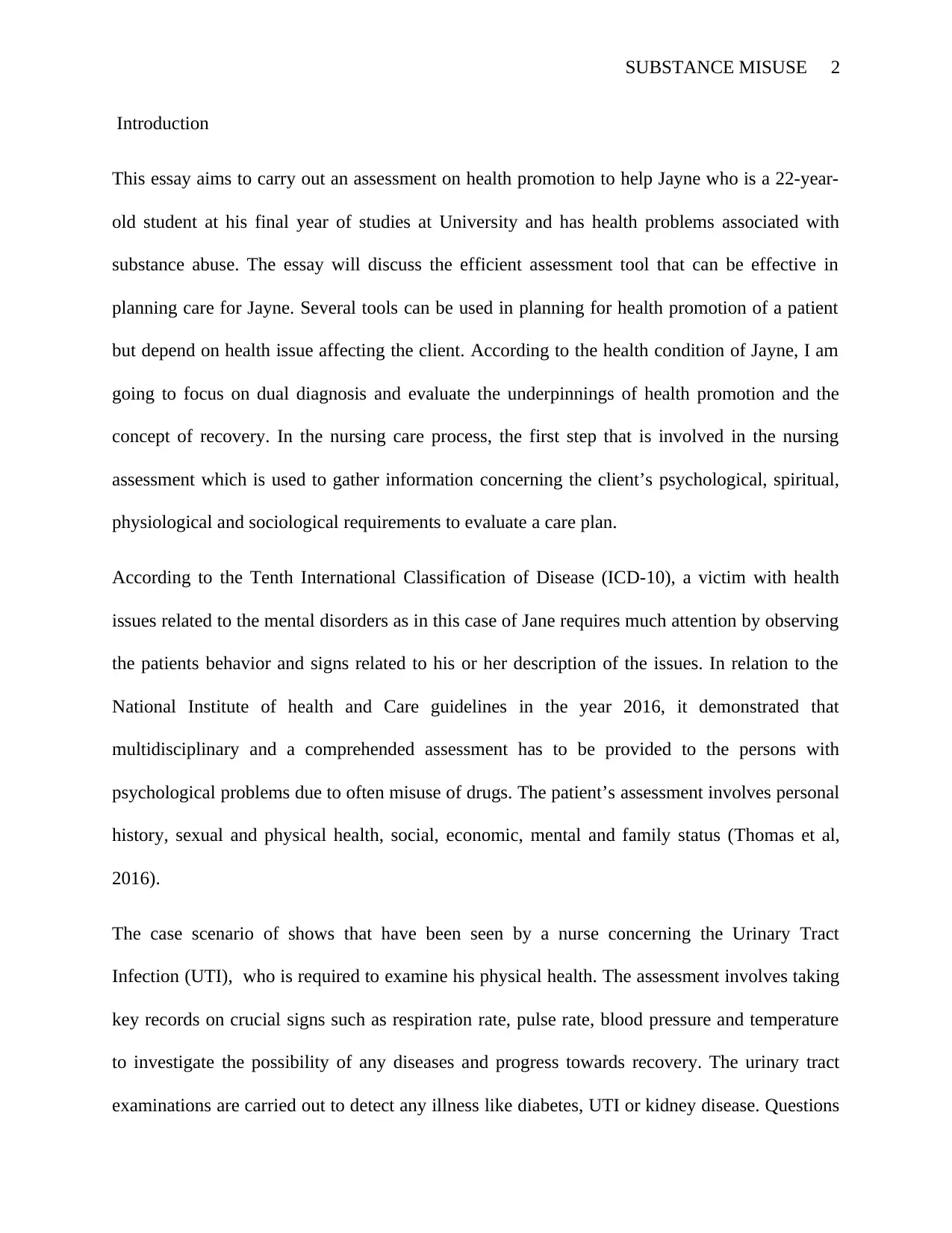
SUBSTANCE MISUSE 2
Introduction
This essay aims to carry out an assessment on health promotion to help Jayne who is a 22-year-
old student at his final year of studies at University and has health problems associated with
substance abuse. The essay will discuss the efficient assessment tool that can be effective in
planning care for Jayne. Several tools can be used in planning for health promotion of a patient
but depend on health issue affecting the client. According to the health condition of Jayne, I am
going to focus on dual diagnosis and evaluate the underpinnings of health promotion and the
concept of recovery. In the nursing care process, the first step that is involved in the nursing
assessment which is used to gather information concerning the client’s psychological, spiritual,
physiological and sociological requirements to evaluate a care plan.
According to the Tenth International Classification of Disease (ICD-10), a victim with health
issues related to the mental disorders as in this case of Jane requires much attention by observing
the patients behavior and signs related to his or her description of the issues. In relation to the
National Institute of health and Care guidelines in the year 2016, it demonstrated that
multidisciplinary and a comprehended assessment has to be provided to the persons with
psychological problems due to often misuse of drugs. The patient’s assessment involves personal
history, sexual and physical health, social, economic, mental and family status (Thomas et al,
2016).
The case scenario of shows that have been seen by a nurse concerning the Urinary Tract
Infection (UTI), who is required to examine his physical health. The assessment involves taking
key records on crucial signs such as respiration rate, pulse rate, blood pressure and temperature
to investigate the possibility of any diseases and progress towards recovery. The urinary tract
examinations are carried out to detect any illness like diabetes, UTI or kidney disease. Questions
Introduction
This essay aims to carry out an assessment on health promotion to help Jayne who is a 22-year-
old student at his final year of studies at University and has health problems associated with
substance abuse. The essay will discuss the efficient assessment tool that can be effective in
planning care for Jayne. Several tools can be used in planning for health promotion of a patient
but depend on health issue affecting the client. According to the health condition of Jayne, I am
going to focus on dual diagnosis and evaluate the underpinnings of health promotion and the
concept of recovery. In the nursing care process, the first step that is involved in the nursing
assessment which is used to gather information concerning the client’s psychological, spiritual,
physiological and sociological requirements to evaluate a care plan.
According to the Tenth International Classification of Disease (ICD-10), a victim with health
issues related to the mental disorders as in this case of Jane requires much attention by observing
the patients behavior and signs related to his or her description of the issues. In relation to the
National Institute of health and Care guidelines in the year 2016, it demonstrated that
multidisciplinary and a comprehended assessment has to be provided to the persons with
psychological problems due to often misuse of drugs. The patient’s assessment involves personal
history, sexual and physical health, social, economic, mental and family status (Thomas et al,
2016).
The case scenario of shows that have been seen by a nurse concerning the Urinary Tract
Infection (UTI), who is required to examine his physical health. The assessment involves taking
key records on crucial signs such as respiration rate, pulse rate, blood pressure and temperature
to investigate the possibility of any diseases and progress towards recovery. The urinary tract
examinations are carried out to detect any illness like diabetes, UTI or kidney disease. Questions
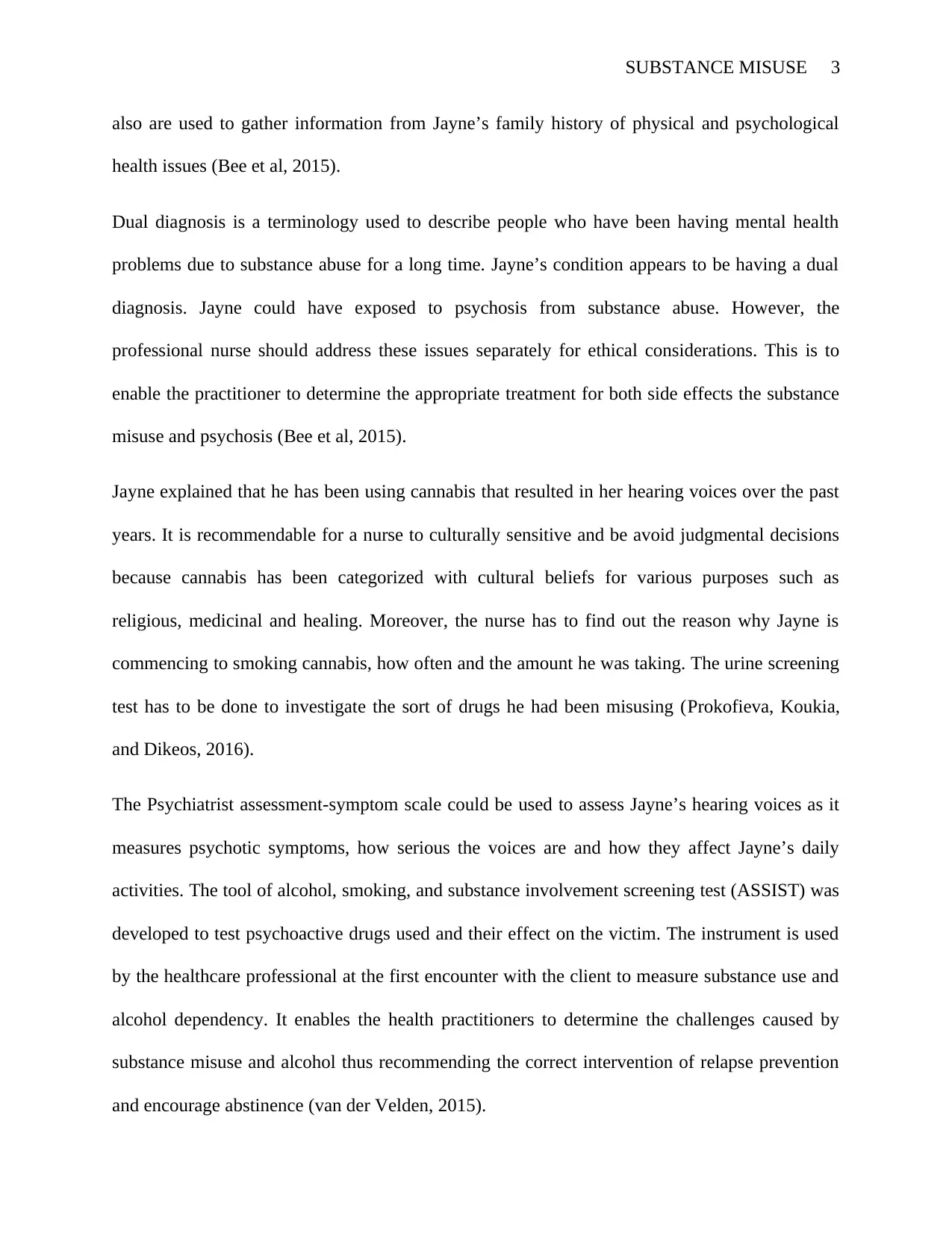
SUBSTANCE MISUSE 3
also are used to gather information from Jayne’s family history of physical and psychological
health issues (Bee et al, 2015).
Dual diagnosis is a terminology used to describe people who have been having mental health
problems due to substance abuse for a long time. Jayne’s condition appears to be having a dual
diagnosis. Jayne could have exposed to psychosis from substance abuse. However, the
professional nurse should address these issues separately for ethical considerations. This is to
enable the practitioner to determine the appropriate treatment for both side effects the substance
misuse and psychosis (Bee et al, 2015).
Jayne explained that he has been using cannabis that resulted in her hearing voices over the past
years. It is recommendable for a nurse to culturally sensitive and be avoid judgmental decisions
because cannabis has been categorized with cultural beliefs for various purposes such as
religious, medicinal and healing. Moreover, the nurse has to find out the reason why Jayne is
commencing to smoking cannabis, how often and the amount he was taking. The urine screening
test has to be done to investigate the sort of drugs he had been misusing (Prokofieva, Koukia,
and Dikeos, 2016).
The Psychiatrist assessment-symptom scale could be used to assess Jayne’s hearing voices as it
measures psychotic symptoms, how serious the voices are and how they affect Jayne’s daily
activities. The tool of alcohol, smoking, and substance involvement screening test (ASSIST) was
developed to test psychoactive drugs used and their effect on the victim. The instrument is used
by the healthcare professional at the first encounter with the client to measure substance use and
alcohol dependency. It enables the health practitioners to determine the challenges caused by
substance misuse and alcohol thus recommending the correct intervention of relapse prevention
and encourage abstinence (van der Velden, 2015).
also are used to gather information from Jayne’s family history of physical and psychological
health issues (Bee et al, 2015).
Dual diagnosis is a terminology used to describe people who have been having mental health
problems due to substance abuse for a long time. Jayne’s condition appears to be having a dual
diagnosis. Jayne could have exposed to psychosis from substance abuse. However, the
professional nurse should address these issues separately for ethical considerations. This is to
enable the practitioner to determine the appropriate treatment for both side effects the substance
misuse and psychosis (Bee et al, 2015).
Jayne explained that he has been using cannabis that resulted in her hearing voices over the past
years. It is recommendable for a nurse to culturally sensitive and be avoid judgmental decisions
because cannabis has been categorized with cultural beliefs for various purposes such as
religious, medicinal and healing. Moreover, the nurse has to find out the reason why Jayne is
commencing to smoking cannabis, how often and the amount he was taking. The urine screening
test has to be done to investigate the sort of drugs he had been misusing (Prokofieva, Koukia,
and Dikeos, 2016).
The Psychiatrist assessment-symptom scale could be used to assess Jayne’s hearing voices as it
measures psychotic symptoms, how serious the voices are and how they affect Jayne’s daily
activities. The tool of alcohol, smoking, and substance involvement screening test (ASSIST) was
developed to test psychoactive drugs used and their effect on the victim. The instrument is used
by the healthcare professional at the first encounter with the client to measure substance use and
alcohol dependency. It enables the health practitioners to determine the challenges caused by
substance misuse and alcohol thus recommending the correct intervention of relapse prevention
and encourage abstinence (van der Velden, 2015).
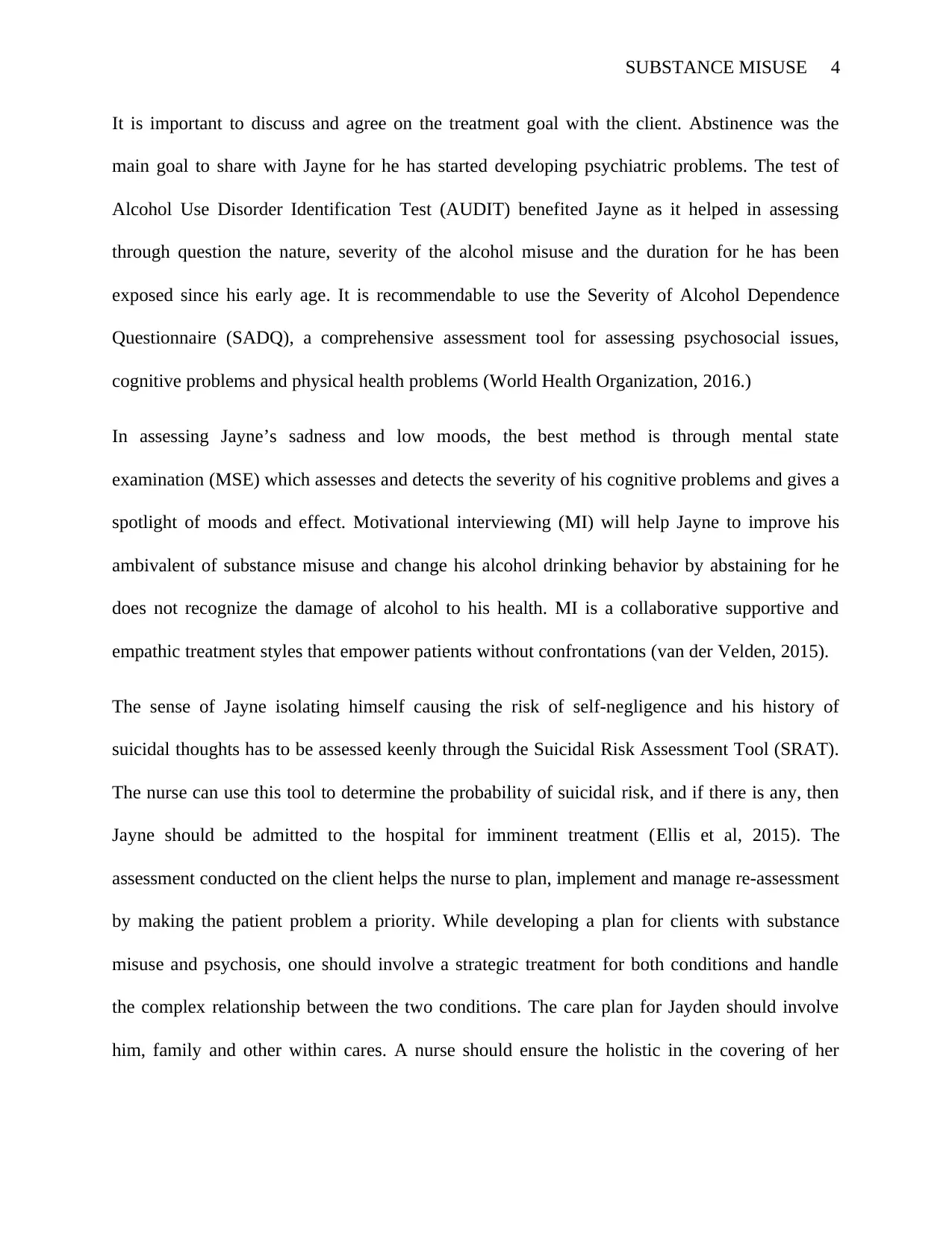
SUBSTANCE MISUSE 4
It is important to discuss and agree on the treatment goal with the client. Abstinence was the
main goal to share with Jayne for he has started developing psychiatric problems. The test of
Alcohol Use Disorder Identification Test (AUDIT) benefited Jayne as it helped in assessing
through question the nature, severity of the alcohol misuse and the duration for he has been
exposed since his early age. It is recommendable to use the Severity of Alcohol Dependence
Questionnaire (SADQ), a comprehensive assessment tool for assessing psychosocial issues,
cognitive problems and physical health problems (World Health Organization, 2016.)
In assessing Jayne’s sadness and low moods, the best method is through mental state
examination (MSE) which assesses and detects the severity of his cognitive problems and gives a
spotlight of moods and effect. Motivational interviewing (MI) will help Jayne to improve his
ambivalent of substance misuse and change his alcohol drinking behavior by abstaining for he
does not recognize the damage of alcohol to his health. MI is a collaborative supportive and
empathic treatment styles that empower patients without confrontations (van der Velden, 2015).
The sense of Jayne isolating himself causing the risk of self-negligence and his history of
suicidal thoughts has to be assessed keenly through the Suicidal Risk Assessment Tool (SRAT).
The nurse can use this tool to determine the probability of suicidal risk, and if there is any, then
Jayne should be admitted to the hospital for imminent treatment (Ellis et al, 2015). The
assessment conducted on the client helps the nurse to plan, implement and manage re-assessment
by making the patient problem a priority. While developing a plan for clients with substance
misuse and psychosis, one should involve a strategic treatment for both conditions and handle
the complex relationship between the two conditions. The care plan for Jayden should involve
him, family and other within cares. A nurse should ensure the holistic in the covering of her
It is important to discuss and agree on the treatment goal with the client. Abstinence was the
main goal to share with Jayne for he has started developing psychiatric problems. The test of
Alcohol Use Disorder Identification Test (AUDIT) benefited Jayne as it helped in assessing
through question the nature, severity of the alcohol misuse and the duration for he has been
exposed since his early age. It is recommendable to use the Severity of Alcohol Dependence
Questionnaire (SADQ), a comprehensive assessment tool for assessing psychosocial issues,
cognitive problems and physical health problems (World Health Organization, 2016.)
In assessing Jayne’s sadness and low moods, the best method is through mental state
examination (MSE) which assesses and detects the severity of his cognitive problems and gives a
spotlight of moods and effect. Motivational interviewing (MI) will help Jayne to improve his
ambivalent of substance misuse and change his alcohol drinking behavior by abstaining for he
does not recognize the damage of alcohol to his health. MI is a collaborative supportive and
empathic treatment styles that empower patients without confrontations (van der Velden, 2015).
The sense of Jayne isolating himself causing the risk of self-negligence and his history of
suicidal thoughts has to be assessed keenly through the Suicidal Risk Assessment Tool (SRAT).
The nurse can use this tool to determine the probability of suicidal risk, and if there is any, then
Jayne should be admitted to the hospital for imminent treatment (Ellis et al, 2015). The
assessment conducted on the client helps the nurse to plan, implement and manage re-assessment
by making the patient problem a priority. While developing a plan for clients with substance
misuse and psychosis, one should involve a strategic treatment for both conditions and handle
the complex relationship between the two conditions. The care plan for Jayden should involve
him, family and other within cares. A nurse should ensure the holistic in the covering of her
Secure Best Marks with AI Grader
Need help grading? Try our AI Grader for instant feedback on your assignments.
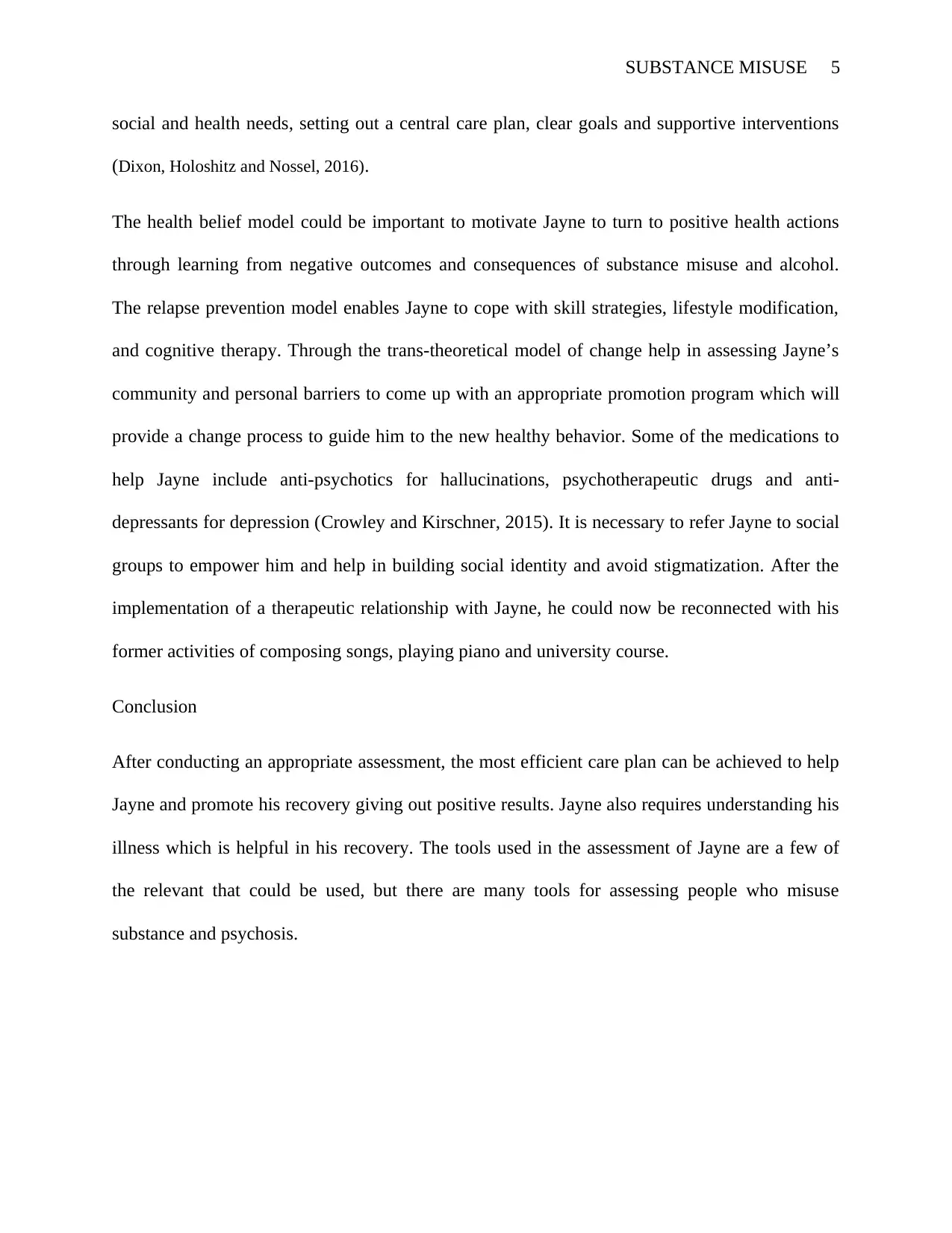
SUBSTANCE MISUSE 5
social and health needs, setting out a central care plan, clear goals and supportive interventions
(Dixon, Holoshitz and Nossel, 2016).
The health belief model could be important to motivate Jayne to turn to positive health actions
through learning from negative outcomes and consequences of substance misuse and alcohol.
The relapse prevention model enables Jayne to cope with skill strategies, lifestyle modification,
and cognitive therapy. Through the trans-theoretical model of change help in assessing Jayne’s
community and personal barriers to come up with an appropriate promotion program which will
provide a change process to guide him to the new healthy behavior. Some of the medications to
help Jayne include anti-psychotics for hallucinations, psychotherapeutic drugs and anti-
depressants for depression (Crowley and Kirschner, 2015). It is necessary to refer Jayne to social
groups to empower him and help in building social identity and avoid stigmatization. After the
implementation of a therapeutic relationship with Jayne, he could now be reconnected with his
former activities of composing songs, playing piano and university course.
Conclusion
After conducting an appropriate assessment, the most efficient care plan can be achieved to help
Jayne and promote his recovery giving out positive results. Jayne also requires understanding his
illness which is helpful in his recovery. The tools used in the assessment of Jayne are a few of
the relevant that could be used, but there are many tools for assessing people who misuse
substance and psychosis.
social and health needs, setting out a central care plan, clear goals and supportive interventions
(Dixon, Holoshitz and Nossel, 2016).
The health belief model could be important to motivate Jayne to turn to positive health actions
through learning from negative outcomes and consequences of substance misuse and alcohol.
The relapse prevention model enables Jayne to cope with skill strategies, lifestyle modification,
and cognitive therapy. Through the trans-theoretical model of change help in assessing Jayne’s
community and personal barriers to come up with an appropriate promotion program which will
provide a change process to guide him to the new healthy behavior. Some of the medications to
help Jayne include anti-psychotics for hallucinations, psychotherapeutic drugs and anti-
depressants for depression (Crowley and Kirschner, 2015). It is necessary to refer Jayne to social
groups to empower him and help in building social identity and avoid stigmatization. After the
implementation of a therapeutic relationship with Jayne, he could now be reconnected with his
former activities of composing songs, playing piano and university course.
Conclusion
After conducting an appropriate assessment, the most efficient care plan can be achieved to help
Jayne and promote his recovery giving out positive results. Jayne also requires understanding his
illness which is helpful in his recovery. The tools used in the assessment of Jayne are a few of
the relevant that could be used, but there are many tools for assessing people who misuse
substance and psychosis.
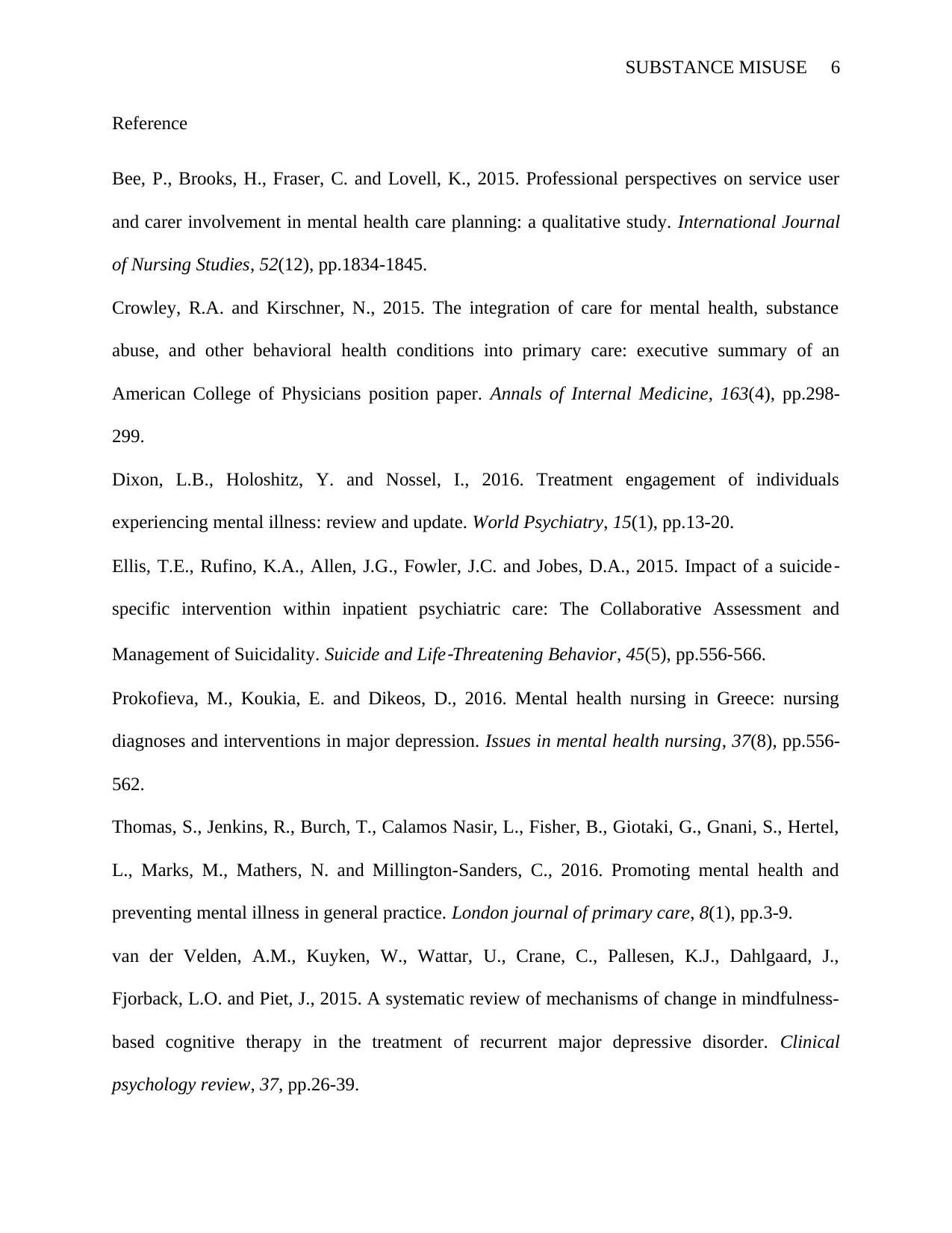
SUBSTANCE MISUSE 6
Reference
Bee, P., Brooks, H., Fraser, C. and Lovell, K., 2015. Professional perspectives on service user
and carer involvement in mental health care planning: a qualitative study. International Journal
of Nursing Studies, 52(12), pp.1834-1845.
Crowley, R.A. and Kirschner, N., 2015. The integration of care for mental health, substance
abuse, and other behavioral health conditions into primary care: executive summary of an
American College of Physicians position paper. Annals of Internal Medicine, 163(4), pp.298-
299.
Dixon, L.B., Holoshitz, Y. and Nossel, I., 2016. Treatment engagement of individuals
experiencing mental illness: review and update. World Psychiatry, 15(1), pp.13-20.
Ellis, T.E., Rufino, K.A., Allen, J.G., Fowler, J.C. and Jobes, D.A., 2015. Impact of a suicide‐
specific intervention within inpatient psychiatric care: The Collaborative Assessment and
Management of Suicidality. Suicide and Life
‐Threatening Behavior, 45(5), pp.556-566.
Prokofieva, M., Koukia, E. and Dikeos, D., 2016. Mental health nursing in Greece: nursing
diagnoses and interventions in major depression. Issues in mental health nursing, 37(8), pp.556-
562.
Thomas, S., Jenkins, R., Burch, T., Calamos Nasir, L., Fisher, B., Giotaki, G., Gnani, S., Hertel,
L., Marks, M., Mathers, N. and Millington-Sanders, C., 2016. Promoting mental health and
preventing mental illness in general practice. London journal of primary care, 8(1), pp.3-9.
van der Velden, A.M., Kuyken, W., Wattar, U., Crane, C., Pallesen, K.J., Dahlgaard, J.,
Fjorback, L.O. and Piet, J., 2015. A systematic review of mechanisms of change in mindfulness-
based cognitive therapy in the treatment of recurrent major depressive disorder. Clinical
psychology review, 37, pp.26-39.
Reference
Bee, P., Brooks, H., Fraser, C. and Lovell, K., 2015. Professional perspectives on service user
and carer involvement in mental health care planning: a qualitative study. International Journal
of Nursing Studies, 52(12), pp.1834-1845.
Crowley, R.A. and Kirschner, N., 2015. The integration of care for mental health, substance
abuse, and other behavioral health conditions into primary care: executive summary of an
American College of Physicians position paper. Annals of Internal Medicine, 163(4), pp.298-
299.
Dixon, L.B., Holoshitz, Y. and Nossel, I., 2016. Treatment engagement of individuals
experiencing mental illness: review and update. World Psychiatry, 15(1), pp.13-20.
Ellis, T.E., Rufino, K.A., Allen, J.G., Fowler, J.C. and Jobes, D.A., 2015. Impact of a suicide‐
specific intervention within inpatient psychiatric care: The Collaborative Assessment and
Management of Suicidality. Suicide and Life
‐Threatening Behavior, 45(5), pp.556-566.
Prokofieva, M., Koukia, E. and Dikeos, D., 2016. Mental health nursing in Greece: nursing
diagnoses and interventions in major depression. Issues in mental health nursing, 37(8), pp.556-
562.
Thomas, S., Jenkins, R., Burch, T., Calamos Nasir, L., Fisher, B., Giotaki, G., Gnani, S., Hertel,
L., Marks, M., Mathers, N. and Millington-Sanders, C., 2016. Promoting mental health and
preventing mental illness in general practice. London journal of primary care, 8(1), pp.3-9.
van der Velden, A.M., Kuyken, W., Wattar, U., Crane, C., Pallesen, K.J., Dahlgaard, J.,
Fjorback, L.O. and Piet, J., 2015. A systematic review of mechanisms of change in mindfulness-
based cognitive therapy in the treatment of recurrent major depressive disorder. Clinical
psychology review, 37, pp.26-39.
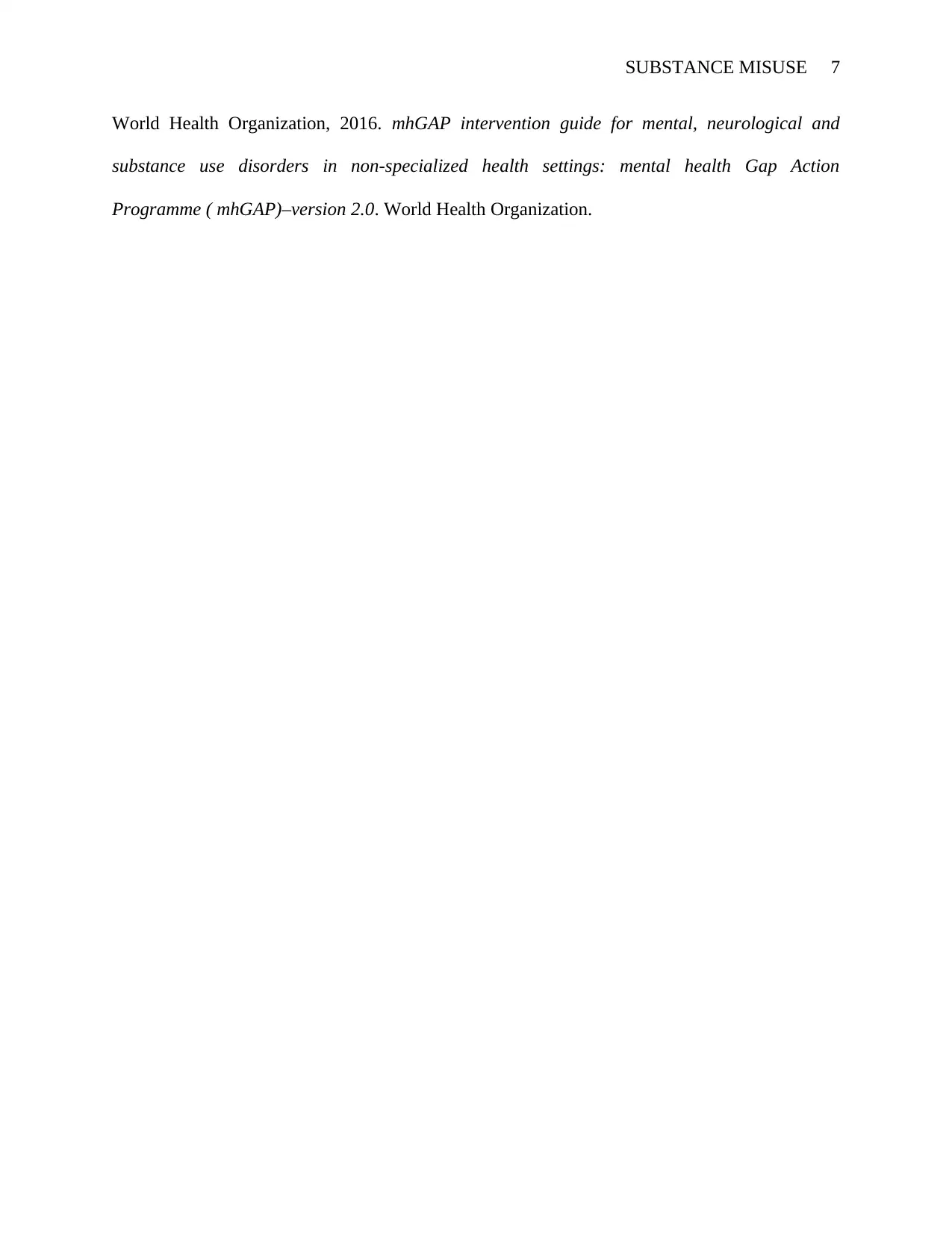
SUBSTANCE MISUSE 7
World Health Organization, 2016. mhGAP intervention guide for mental, neurological and
substance use disorders in non-specialized health settings: mental health Gap Action
Programme ( mhGAP)–version 2.0. World Health Organization.
World Health Organization, 2016. mhGAP intervention guide for mental, neurological and
substance use disorders in non-specialized health settings: mental health Gap Action
Programme ( mhGAP)–version 2.0. World Health Organization.
1 out of 7
Related Documents
Your All-in-One AI-Powered Toolkit for Academic Success.
+13062052269
info@desklib.com
Available 24*7 on WhatsApp / Email
![[object Object]](/_next/static/media/star-bottom.7253800d.svg)
Unlock your academic potential
© 2024 | Zucol Services PVT LTD | All rights reserved.





